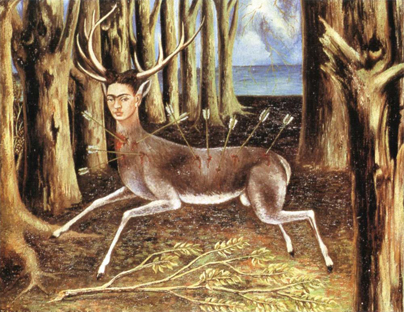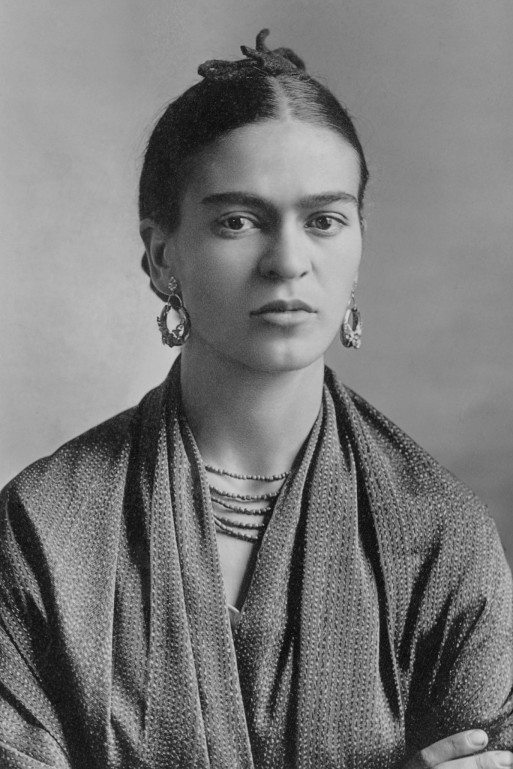
Credit: Wikimedia Commons
Choosing just one Frida Kahlo work about death isn’t an easy task. The artist flirted with death in nearly every painting she released, owing to her numerous near-death experiences.
One of my favorite Kahlo paintings is also one of her most literal interpretations of her hardships and the inevitability of death. “La Venadita” (which translates from Spanish into “The Little Deer”) depicts Kahlo as a grey stag, only identifiable by her face and signature eyebrows. An alternate title for the piece is called “El Venado Herido,” which means “The Wounded Deer.”
Before discussing the painting, I need to talk about the health issues that influenced all of Kahlo’s works. As a child, Kahlo suffered from polio, which left one of her legs much weaker than the other. When she was 18, she was in a bus accident which left her spine, pelvis, ribs and right leg severely impaired for life. She later would lose the lower half of her right leg entirely, and had to wear a special corset to keep her spine in alignment. Kahlo spent a good portion of her life bedridden.
In the deer’s body, she appears to be almost hovering above the forest floor, her long, spindly legs splayed around her.
In the painting, Kahlo’s eyes stare at the viewer without expression, much like her other self-portraits. This leaves all of the focus on the symbolism of the scene, and shows viewers that, despite her immense suffering, the artist’s will remained strong. In the deer’s body, she appears to be almost hovering above the forest floor, her long, spindly legs splayed around her. Nine arrows pierce the deer’s torso.

Credit: Wikimedia Commons
The arrows in the painting clearly represent the many hardships Kahlo endured in life, serving as stand-ins both for her physical pain and the emotional wounds within.
The symbolism of the deer can be interpreted in several ways. The deer may represent the pet deer Kahlo had as a child. On the other hand, it may be a symbol of Kahlo’s physical injuries. In ancient Colombian tradition, the deer is said to represent the right foot, and Kahlo’s own right foot was severely damaged. Years after Kahlo painted this piece, her right leg had to be amputated at the knee due to gangrene. In the painting, the deer’s right leg is raised.
In the painting, nine arrows pierce the deer’s skin, and nine tree trunks line the background.
Kahlo likely also found symbolic meaning in the number nine because she was born on the ninth day of the Aztec calendar. In the painting, nine arrows pierce the deer’s skin, and nine tree trunks line the background. It’s possible that the artist considered the number nine to be unlucky, as it was strongly associated with the underworld in Aztec tradition. In this sense, the work highlights Kahlo’s sense of fatalism — the belief that her destiny and great suffering were written in the stars from the day she was born.
This fatalism seems to be at odds with Kahlo’s interest in Buddhism, which she studied near the end of her life. Art historians point out that Kahlo scribbled “carma” in the left-hand corner of the painting next to her signature. This was likely a reference to the Buddhist term “karma,” which is the belief that one’s actions in this life determine the course of future incarnations. This seems to contradict Kahlo’s belief that her fate was sealed long before she was born. Yet the concepts are more similar than they appear at first glance. Karma also implies that a person’s actions in a past life impact his present place in the world, which is a form of fatalism. Yet it also suggests the possibility of changing the course of future lives through one’s actions today.
In traditional Mexican funeral rites, a tree branch is placed on a grave as a symbol of mourning.
I also cannot talk about “La Venadita” without mentioning the tree branch that rests in the foreground of the painting. Other than the deer itself, it is the most prominent part of the piece, and it has significant meaning for the painting as a whole. In traditional Mexican funeral rites, a tree branch is placed on a grave as a symbol of mourning. By including a broken tree branch in the foreground of her painting, Kahlo is acknowledging her mortality and, perhaps, welcoming her impending death.
Kahlo died at age 47, less than 10 years after she painted “La Venadita.” One of her last diary entries said, “I hope the exit is joyful — and I hope never to return.”

 Literal and Figurative Wounds in Frida Kahlo’s “La Venadita”
Literal and Figurative Wounds in Frida Kahlo’s “La Venadita”


 “In Case You Don’t Live Forever” by Ben Platt
“In Case You Don’t Live Forever” by Ben Platt
 Our Monthly Tip: Make an “In Case of Death” File to Ease Loved One’s Grief
Our Monthly Tip: Make an “In Case of Death” File to Ease Loved One’s Grief
 Passing of Beloved Comedian Births a New Comedy Festival
Passing of Beloved Comedian Births a New Comedy Festival














